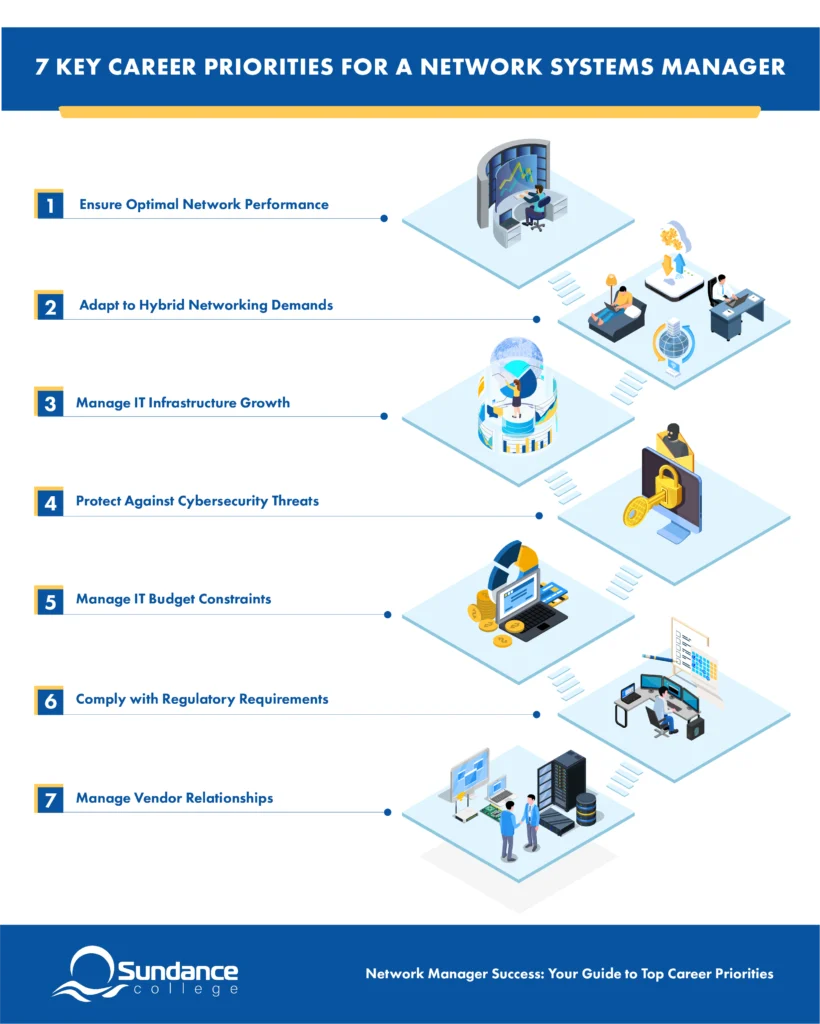Blog / Network Manager Success: Your Guide to Top Career Priorities
Network Manager Success: Your Guide to Top Career Priorities

Network Systems Manager Diploma
- Network Administrator
- Network Systems Administrator
- IT Support Technician
- Network Support Technician
Table of Contents
Navigating a career in network systems management can be as complex and dynamic as the networks you oversee. You’re responsible for ensuring seamless connectivity, securing data, and adapting to ever-evolving technologies.
From technical issues to budget constraints, each task is an opportunity to enhance your skills and become successful in your field.
To help aspiring network managers, IT technicians, network administrators, network analysts, and system administrators like you succeed, we’ve outlined seven top priorities you’ll have in your career.
We’ve also provided practical network systems management strategies to help you efficiently carry out your prioritized tasks. These strategies are part of what our students learn in their Network Systems Manager (NSM) Diploma, as illustrated by one of our instructors, Yokishan K.
Listen to: “Network Manager Success: Your Guide to Top Career Priorities”
Priority 1. Ensuring Optimal Network Performance
What’s the main thing everyone in a company expects from a network systems manager? A network that runs smoothly 24/7, regardless of the number of connected devices, the amount of data being processed, or the number of active users. Plus, they expect a stable and speedy Wi-Fi connection in all corners of the office.
Strategy: Optimizing Network Equipment And Managing Traffic
Yokishan explains: “During COVID, we saw an increased use of mobile phones, virtual private networks (VPNs), and cloud services. This period popularized professional tools like speed test tools for optimizing performance. In network systems management, these tools can measure data transfer speeds and ensure privacy and security.”
For stable network performance at all times, systems managers need to:
- Use reliable routers, switches, and other networking equipment to handle high traffic volumes
- Distribute network traffic evenly across servers to prevent any single server from becoming a bottleneck
- Use monitoring tools to track network performance and identify issues before they become major problems
- Regularly update and optimize network settings to ensure peak performance
By doing this, you can ensure seamless network operations, meet company expectations, and enhance your reputation as a reliable network systems manager.
Priority 2. Adapting to Hybrid Networking Demands
Many companies are switching from having everyone work in the office to a hybrid model, where employees can work remotely and in the office. Let’s say employees at your company follow this hybrid model and work from home a few days a week.
For network systems managers, this means they need to make sure the company’s network is secure and runs smoothly no matter where employees are working.
Strategy: Securing And Enhancing Hybrid Network Infrastructure
As a network manager, you should:
- Use virtual private networks (VPNs) to let employees securely access company files and programs from home.
- Protect the network from cyberattacks with strong passwords, multi-factor authentication (MFA), and security software to keep hackers out.
- Upgrade the network bandwidth and deploy content delivery networks (CDNs) to improve data delivery speeds for remote users.
By mastering these solutions, you can ensure the company’s network is reliable and secure, making the hybrid network environments a success.
Priority 3. Managing IT Infrastructure Growth
Your employer’s networks can include wired, wireless, on-premises, distributed, and remote environments, along with cloud infrastructures. As businesses evolve with new technologies and functionalities to retain and attract customers, you may find yourself tasked with implementing new applications. For example:
- Multimedia applications that require better Quality of Service (QoS) and multicasting protocols
- High-performance applications such as high-definition video and advanced graphics that demand increased bandwidth
- New network devices such as wireless access points, Voice over Internet Protocol (VoIP) phones, and surveillance cameras that need Power over Ethernet (PoE) and auto-configuration protocols
- Transitioning from Internet Protocol version 4 (IPv4) to IPv6 to meet demands in data security, Internet of Things (IoT), or cloud computing
Adapting to these changes and ensuring your network infrastructure can handle growth efficiently is critical for a network systems manager.
Strategy: Scalable IT Infrastructure Management
Yokishan notes that “companies like Amazon and Facebook started with small user bases and didn’t anticipate how many users would eventually access their platforms simultaneously. As demand grows, so do the requirements for security and data privacy. It’s crucial to optimize network usage and allocate resources effectively. By using appropriate monitoring tools, network managers can control systems efficiently and minimize risks.”
Going into detail, with the number of network infrastructure items growing, you, as a network systems manager, should:
- Use centralized network management software to add, configure, map, and troubleshoot network components from a single console
- Regularly track down the network to promptly fix the root cause of issues
- Ensure the network scalability to effectively support expanding business operations and future growth
By mastering these strategies, you can deliver efficient network infrastructure management as the business evolves.

Priority 4. Protecting Against Cybersecurity Threats
On April 28, 2024, London Drugs faced a significant cybersecurity incident that forced around 80 stores in Western Canada to close temporarily. The company had to review billions of lines of code to find and fix the data breach. Although no customer data was compromised, they had to rebuild their data infrastructure with third-party experts to restore their operations safely.
As a network systems manager, your job is to prevent devastating cyberattacks like the one at London Drugs.
Strategy: Strengthening Cybersecurity Measures
According to Yokishan, “We’ve all heard about ransomware attacks. Some businesses can’t afford to stop their operations, even for an hour, because it could cost them a fortune. Network systems managers must always have a backup plan. If something goes wrong, you need a backup system to keep things running.”
Here is more on how you can keep your organization’s network secure:
- Deploy firewalls, antivirus programs, and intrusion detection systems to defend against attacks
- Require users to confirm their identity with two or more verification methods
- Use Public Key Infrastructure (PKI) to secure communications and verify the identities of users, devices, and services on your network
- Conduct regular security audits to identify and address vulnerabilities promptly
- Educate employees on cybersecurity best practices, such as recognizing phishing emails and using strong passwords with a mix of uppercase and lowercase letters, numbers, and special characters
- Regularly update all software to protect against known vulnerabilities
By following these steps, you can help ensure your organization’s sensitive data remains safe and secure.
Priority 5. Managing IT Budget Constraints
For network systems managers, working within a tight budget can be quite challenging. Companies often want top-notch technology without spending too much money.
Additionally, budget constraints can make it difficult to respond quickly to unexpected issues, such as equipment failures or security breaches. If you can’t afford to fix things fast, they might get worse down the line.
Strategy: Cost-Effective IT Budget Management
To handle this challenge, you need smart planning and decision-making. Here is how to manage your budget cost-effectiveness:
- Opt for multifunctional hardware like routers doubling as firewalls, switches serving as servers, and workstations acting as clients
- Consider open-source software options as a budget-friendly alternative to pricey proprietary software
- Leverage cloud services for their flexibility and scalability, enabling payment based on usage
- Select devices with upgrade capabilities, allowing older devices to be shifted to less critical network areas over time
By prioritizing essential components, choosing cost-effective solutions, and planning for future upgrades, you can build and maintain robust network reliability even with budget constraints.

Priority 6. Complying with Regulatory Requirements
Compliance with regulations and industry standards is crucial for network systems. Different industries have specific guidelines for data privacy, security, and network management.
For example, working as a network manager for a healthcare organization, you must adhere to regulations like the Health Insurance Portability and Accountability Act (HIPAA), to protect patient data privacy and security.
Navigating these requirements means you need to understand the laws well and have strong policies in place to make sure the network infrastructure follows all the regulations.
Strategy: Staying Updated With Regulatory Standards
To tackle this challenge, you will need to:
- Stay informed about updates to regulations in your industry
- Get advice from legal experts to make sure you’re following the rules
- Keep thorough records of your compliance efforts
- Regularly review and update your policies to keep up with changes in regulations
Yokishan adds: “Data privacy and user protection are critical. Sensitive data like credit card details and passwords must be secure, even from employees. Implementing strict policies and secure payment processes is essential to protect user data and comply with regulations.”
By staying on top of regulations and following these steps, you can protect your organization’s reputation and interests and succeed in your network manager role.
Priority 7. Managing Vendor Relationships
Different hardware and software keep your network running smoothly. Need more network switches to handle increased data traffic or specialized motherboards for an interactive media project? Or perhaps some new features for your customer management system?
Third-party vendors are the ones you’ll usually turn to for selecting the right tools, negotiating pricing and terms, and coordinating the procurement process. Plus, you’ll need to collaborate with them on ongoing support and maintenance.
However, managing long-term vendor relationships isn’t always easy. It involves dealing with contracts, resolving disputes, and ensuring timely deliveries.
Strategy: Building Strong Partnerships
Yokishan notes that “building relationships with vendors is crucial. By doing so, you can get extended warranties, better discounts when buying in bulk, and overall improved service. It’s the network system manager’s responsibility to establish rapport with third-party dealers to manage expenses effectively.”
Here is some advice on how you can deliver good vendor management in IT:
- Select vendors based on their reliability, compatibility, and support services
- Maintain open and consistent communication with vendors to build strong partnerships based on mutual trust, respect, and collaboration
- Establish clear Key Performance Indicators (KPIs) and service level agreements (SLAs) with vendors to measure performance and hold them accountable for meeting agreed-upon standards
By implementing these strategies, you will be able to effectively manage vendor relationships and drive success in your organizations’ IT initiatives.
How Sundance College Prepares You for Network Systems Management Success

A career as a network systems manager is both challenging and highly rewarding. By equipping yourself with the right knowledge and skills to address the key challenges, you can position yourself for success earning a base annual salary of $80,000.
How can you gain the relevant network systems manager skills? That’s exactly what our Network Systems Management diploma program is designed to provide.
As Ruel M., one of our Network Systems Manager diploma students, shared: “I was excited to learn new and valuable skills that can never be taken away from me. I’ve refreshed my knowledge and honed my skills to respond correctly and effectively to various situations. With guidance from my instructor, I feel prepared to handle any challenges I may face in the future.”
Reach out to our advisors to learn more about the program, your instructors, and the enrollment process by filling out this contact form.
Related Blogs
Subscribe for more career advice
Blog Categories
Share on:
